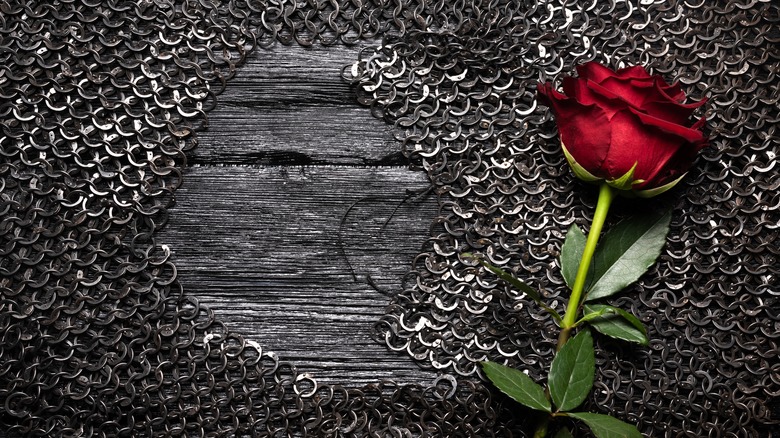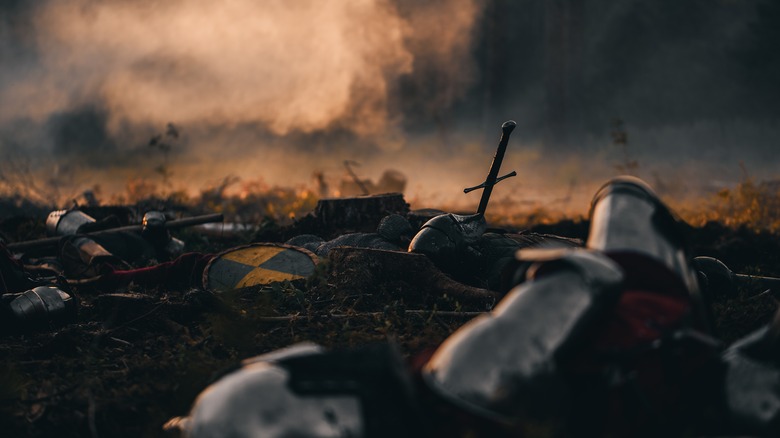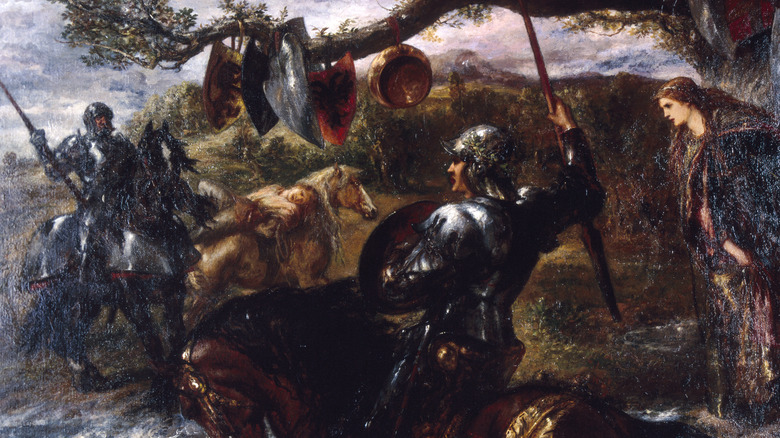The Surprising True Origins Of Chivalry
Time to clear up some historical untruths, folks. Knights were not — repeat, zero percent — gallant, noble, righteous, chivalrous battlers of ne'er-do-wells who swept maidens off their feet and tossed them onto the backs of their saddles to gallop them away from danger. They were thugs, as History outlines; hired brutes. Part of an unchecked warrior-elite class of society that wreaked hell on peasants by tearing through their towns for fun. You know that scene from "Monty Python and the Holy Grail" where Lancelot (John Cleese) rampages through a wedding ceremony murdering about a hundred people? That's what that joke was about.
But the notion of a gallant, noble, righteous, etc., etc., knight does exist for a reason (albeit nothing based on historical reality). Such a knightly vision is part of a propaganda campaign so deeply ingrained, so successful in its inculcation, that it survived about 800 years to the present. That tradition is called the "chivalric romance," storytelling at its finest and taken as fact like so many other fictions, as World History explains. And yes, Lancelot is one of this genre's better-known characters.
Chivalric romances were a genre of literature, just like "thriller," "fantasy," or "sci-fi" nowadays. They were written with the express purpose of redirecting the savagery of the military. Rather than the church giving knights sets of do's and don'ts, which didn't work, writers found a way to repurpose the innately destructive tendencies of metal-clad men into something a bit more genteel.
Rich brutes with blades
Before (and through) the "High Middle Ages" (1,000 – 1,300 CE), medieval nobility were far from the prissy, drawing-room snobs you might imagine from 19th-century Victorian England. Aristocrats were soldiers, not bureaucratic mouthpieces hidden behind podiums. As History overviews, Europe's wealthiest were its most violent, the ones who both started, and fought in, wars. Imagine if all modern-day Marines came from Senators' families and diplomats' households. From Late Antiquity on (3rd – 7th centuries CE, roundabouts), there simply wasn't enough time and money to train and equip standing armies of commoners.
So if someone wanted vertical mobility in medieval society? Find a count (someone in charge of a county), a duke (someone in charge of a duchy), or even a king, and swear loyalty. They give you military training and equipment (i.e., sword, armor, horse), and you promise to use that equipment to fight for them. By the 13th century, the job became hereditary, as World History outlines. The noble's duties? Ostensibly, to protect people. From who? Well, from other nobles. Nobles caused the need for protection from nobles.
It's not too hard to imagine the kind of trouble that rich, undereducated men with deadly weapons got into. Knights got easily bored, and even their "downtime" caused plenty of death. Medieval tournaments, for instance, didn't begin as highly regulated, regimented affairs. Through the mid-12th century (per World History), they were composed of fully kitted-out knights using entire villages as their hack-and-slash war-game playgrounds.
The Peace and Truce of God
The church took its first crack at keeping knights in check, as Academic outlines. In 989 CE, clergy who met at the Synod of Charroux in modern-day France announced the "Peace of God" (Pax Dei). Pax Dei insisted that military personnel refrain from injuring or robbing non-military folks. This included peasants, pregnant women, the elderly, children, priests, etc. Of particular note was the proviso to neither strike nor steal donkeys.
The "Truce of God" came next, as Medieval Histories recounts. Institutionalized in 1027 CE and expanded through the 1030s and 40s, the Truce of God forbade nobles from murdering each other on Sundays and other holy days. Drogo, bishop of Terouanne, wrote in 1063, "You shall also keep this peace every day of the week from the beginning of Advent to the octave of Epiphany and from the beginning of Lent to the octave of Easter, and from the feast of Rogations [the Monday before Ascension Day] to the octave of Pentecost."
"Courtesy books" were another less religious way of driving home a modicum of proper public behavior and common morals. Via Medievalists, they were a genre of little booklets that took off in the 1100s and continued for hundreds of years. What wisdom did they contain? Zingers like, "Don't spit on the table," and, "Don't chew on bones because that is what dogs do."
All such attempts failed. They were dialectic, and man-babies with swords chaffed at being told what they couldn't do.
Knightly fantasies of chivalric heroism
Enter the medieval fiction writer. As Origins summarizes, writers didn't wield papal threats of ex-communication, but paper tales of courtly love and heroic deeds. Monsters, damsels (the single and attractive kind), valiant steed-saddled warriors scouring the land for threats and the helpless: chivalric romances had it all. They were the perfect carrot, rather than stick. Church councils "praying to be delivered from knights" (via History) in the mid-1000s found their prayers answered in the form of fictional characters, most notably King Arthur, Guinevere, Lancelot, and the Knights of the Round Table.
"To be a great knight, you ought to have consideration of civilians, for women," says Jennifer Goodman Wollock, professor of medieval studies at Texas A&M University. As the propaganda went, "The greatest knights are inspired by the love of some lady out there and want to impress her and win her love by doing great deeds." This code, dubbed "chivalry," derives from the same word as "cavalry," from the French "cheval," for horse. Knights, in the word's original sense, were cavalry.
Over time, this chivalric vision got mixed in with a bit of 19th-century poetry, the kind that gave us our modern vision of "romantic love." And nowadays, we've envisioned our fictionalized portrait of gallant, honor-bound medieval knights. It's more palatable, sure, and simplistic enough to satisfy rose-tinted wishes for faultless heroes of yore. But we might as well believe King Arthur received Excalibur from the Lady of the Lake.



